Below is an excerpt from my book; enjoy. Sorry I'm having some trouble aligning the epigraphs.
Chapter 3
Mechanical Dolls and Automata
We pulled our dolls along behind the bars of our crib, dragged them into the heavy folds of illness. They appeared in dreams and were tied up in the disasters of feverish nights. They did not make any effort of their own; they were lying at the edge of childhood sleep, maybe filled with rudimentary thoughts of falling off,and they let tthemselves be dreamed. Just as they were accustomed to be lived tirelessly through someone else's power during the day.
Rainer Maria Rilke, "Dolls"
The machine is a material expression of the human spirit.
G. De Reynold
Automata and mechanical dolls belong in a book about metal dolls because many of their parts, including their mechanisms, are made of metal. These are the dolls and toys of which dreams are made. They are the magnificent dancing dolls of The Nutcracker Suite, and the dancing figures of Disneyland's "It's a Small World" attraction. Though they range from simple to complex, automata have origins that date back at least to Ancient Egypt. They were particularly popular in the Middle Ages. One of the earliest attempts at making an automaton was a Medieval Nuremburg crib built to contain live birds in its base. The birds' frantic attempts to escape made the figures move (Fraser 171). Also, among the earliest automated figures were those inside the Strassburg Cathedral clocktower. A mechanism allowed the figures of the Virgin and Three Wise Men to bow while a rooster moved its head and a crow flapped its wings.
Leonardo da Vinci is said to have created some marvelous mechanical figures while at the court of Lodovico Sforza, but we know of them only through his hints and through the sketches in his notebooks. The mechanical toys of Gustavas Adolphus of Sweden, however, still exist to give us a glimpse of early automated dolls. The dolls date to 1632 and dance. They are operated by a mechanism hidden under the lady's skirt. The lady has lost her head, but her male partner is still intact. The dolls are dressed in silk and gilt lace. Other early clockwork figures from this period were operated by steel springs and were called Jacquemarts (Hillier Automata 111).
Mechanical figures were very popular by the eighteenth century and there was great competition among artisans who invented them. Some examples were not automatons; instead, they were French Court dolls made of wood with hollow heads, meant to be operated manually. The information below about these dolls comes from Jean Lotz's Internet Antique Wood Doll Gallery. These figures were clearly meant for adult entertainment and are often anatomically correct. There is a cavity in the head which opens. Former curator for the Museum of the City of New York and doll collector, John Noble, suggests that a cabbage could have been placed in the cavity as a joke. Lotz claims that the compartment could also contain miniature scenes, or tiny gifts and jewels. The author has read of example in various books that were used as spy dolls, even as late as the American Civil War. Marie Antoinette and the Princess Lamballe supposedly had an example. Considering what happened to the heads of both of these ladies, the fact that their dolls heads opened and were empty is a little ironic.
One famous doll eighteenth century doll is the Dulcimer player. Invented by Roentgen and Kintzing, it dates from 1780 and is supposed to have belonged to Marie Antoinette. The dulcimer player was so popular, that the composer Glück composed special music for her. In the author's opinion, she is the forerunner of modern computerized dolls such as Pamela, Julie, Cricket, Teddy Ruxpin, Computer Interactive Talk with Me Barbie, and others. Another doll made in 1764 appears to play the guitar. While she plays, she leans forward. As is the case with many of these early automata, a complicated mechanism that moves on a wheeled frame is hidden under her skirt.
Another famous figure is the clavichord player, circa 1774, by Jaquet-Droz. Today, this amazing doll is in the Museum of Art and History in Neuchatel, Switzerland (Valentry 71). The clavichord player actually plays the keys of her instrument, and her chest rises and falls, as though she were breathing (74). Anyone familiar with the modern Mme. Tussaud Sleeping Beauty will be amazed at the similar effect in the clavichord girl. The clavichord player was made by the now famous father and son team known primarily for being clock makers (72). According to Duane Valentry in his essay "The Impossible Dolls," it was the son, Pierre, who made the doll. He allegedly called automated doll-making his hobby and referred to it as "picturesque mechanics" (73). And, picturesque these dolls certainly are. Pierre was apparently interested in realism, and he strove to make his creations as life-like as possible (73). Valentry writes that Pierre's biggest challenge was to install the sophisticated mechanism needed to make the dolls perform into the relatively small doll bodies. Valentry says that the younger Jaquet-Droz "worked his problems out cleverly, using two sets of wheel works and devising a system that set these alternately in motion without interruption until the last gesture" (74).
Pierre's doll called "The Artist" took two years to finish; the doll can draw a rabbit, dog, and child, with the doll's eyes following each stroke of the pencil, as if it were concentrating (Valentry 74). This doll, too, is famous today. The doll has a wooden heard, torso and limbs. He wears a wig and has realistic eyes. He is approximately 27 inches high. According to Alfred Chapuis and Edmond Droz, the boy "dips his quill in an inkwell on his right, shakes it twice, puts his hand at the top of the page and then pauses" (74). Further pressure on a lever makes the mechanism move, and the boy begins to write. Today, there is a mechanic on duty to ensure that the automatons of Neuchatel will endure another 200 years (Valentry 74). The Jaquet-Droz dolls were part of an exhibit at the Smithsonian in 1961 (Fawcett 50). Accompanying them was Edmund Droz, descendant of their creator, and professor of mathematics (50).
If dolls can play instruments, draw, and breathe, then they can certainly perform everyday functions like eating and walking. Chronologically speaking, walking dolls seem to be a fairly modern development. Yet, they appeared even earlier than talking models. One engraving dated 1743 shows a doll walking across a floor as a room full of delighted people watch (Hillier DDM 113).
One interesting variation on the walking doll is a rare example pushing a three wheel carriage. One thing that makes this toy so unusual is that the maker himself provided a small doll occupant for the carriage. About eleven years ago, the author saw such a doll at a doll show in St. Charles, IL. The doll was eight inches long with a rubber head. The molded blonde hair was held back with a band in the style of Alice in Wonderland. The features were painted. A small necklace with a cross was painted around the neck. The arms were also rubber. The torso and legs were made of a series of metal links, chained together. The dress was tattered gauze that may once have been blue. In bad condition, and without the mechanism or carriage, this 1850's doll coast $500.
John Noble shows variations of this type of figure in his book, Dolls. On August 25, 1868, W.F. Godwin of East New York took out a patent, No. 81, 491, for an "automatic toy." This doll had a papier-maché head with metal hands and feet with swivel ankles. The hands were made to fit around the handle of a doll carriage that it either pulled or pushed. Originally, this doll may have belonged to the Amana Society, a religious sect that still makes its home in Amana, IA (Young 140).
Walking dolls either pushing carriages or carrying things continued to be popular through the end of the nineteenth century. Alexandre Nicholas Théroude made dolls in Paris between 1842-95 (Coleman I 614). He specialized in mechanical dolls. He advertised as early as 1843 that his dolls were sent even to the French provinces and abroad (614). In 1849, Théroude won a bronze medal at the Paris Exposition. By 1852, he was trying to make his dolls even more realistic, and received a French patent for an internal mechanism which would give his dolls sound and movement. He must have been successful, for in 1855, he won a silver medal for his efforts at the Paris Exposition (614). He also won prizes at the 1862 and 1867 London and Paris Expositions, respectively (614). All his success made him cocky, apparently, for in 1856, he began to brag he invented the "talking" doll, which is not really true. The heads of these dolls were composition, with pupil-less glass eyes, and upper and lower rows of bamboo teeth. Because of the teeth, they look as if they are baring their fangs at someone. The dolls walk by way of a mechanical device with wheels on which their feet rest (Coleman I 615).
A French Christmas toy catalog from 1875-1876 shows a small doll representing a uniformed young man mounted on a four-wheeled platform. He carries a balloon with the words "Louvre" written on it, thus advertising a famous department store of the time. His arms are full of toys, including a wrapped box, a Polichinelle clown, and a tiny toy dog. He is called in the catalog, "Le Groom Des Grands Magazine Du Louvre" (Theimer 11). In this example, the child pulled the wheeled figure on its platform to make it "walk," thereby providing the mechanism. This is probably not a true automaton, then, because no motor or mechanism allows the doll to move on its own power. One might think of the difference as one between a horse and buggy or trailer pulled by a car, and a motor vehicle of any kind which operates with its own mechanical force.
Subscribe to:
Post Comments (Atom)


























































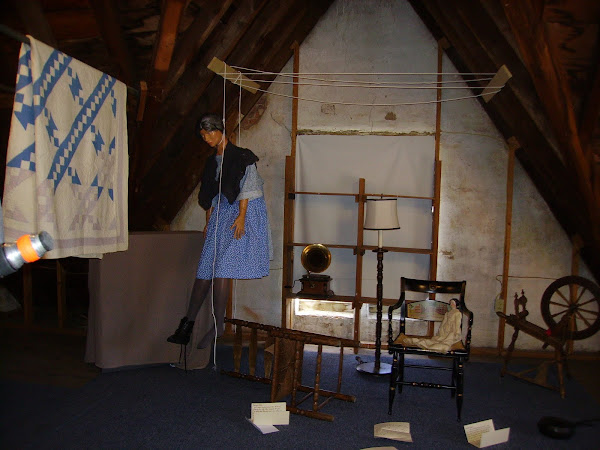
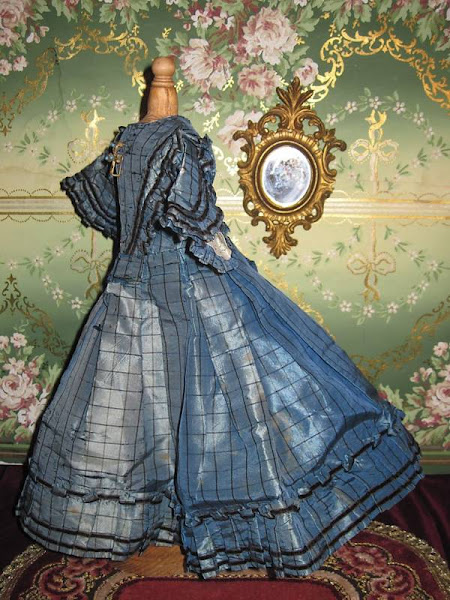wCWk~%24(KGrHqV,!h8Ew5GsnS3dBMUy3MzVPg~~_3.jpg)


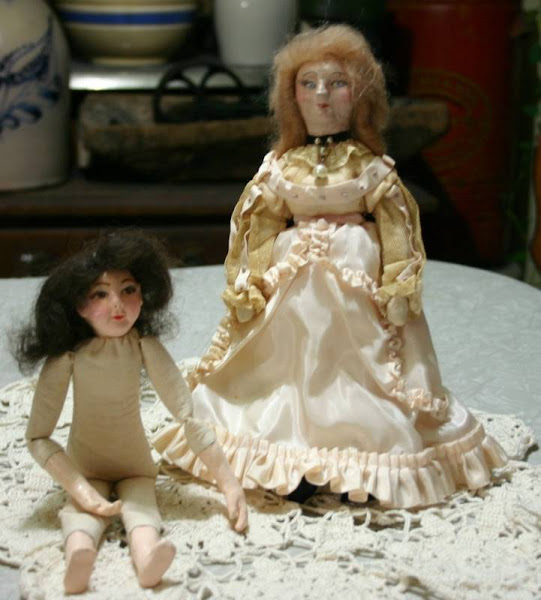









































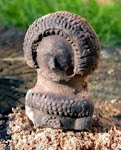
















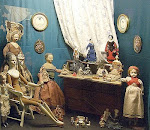



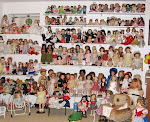
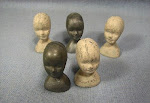



No comments:
Post a Comment